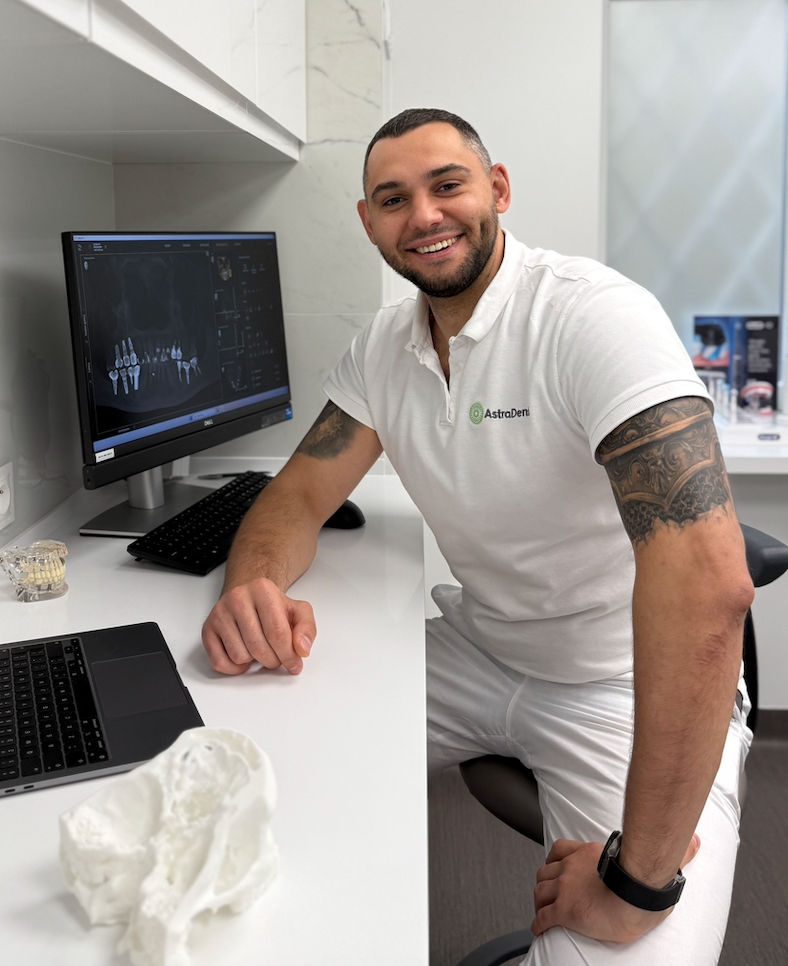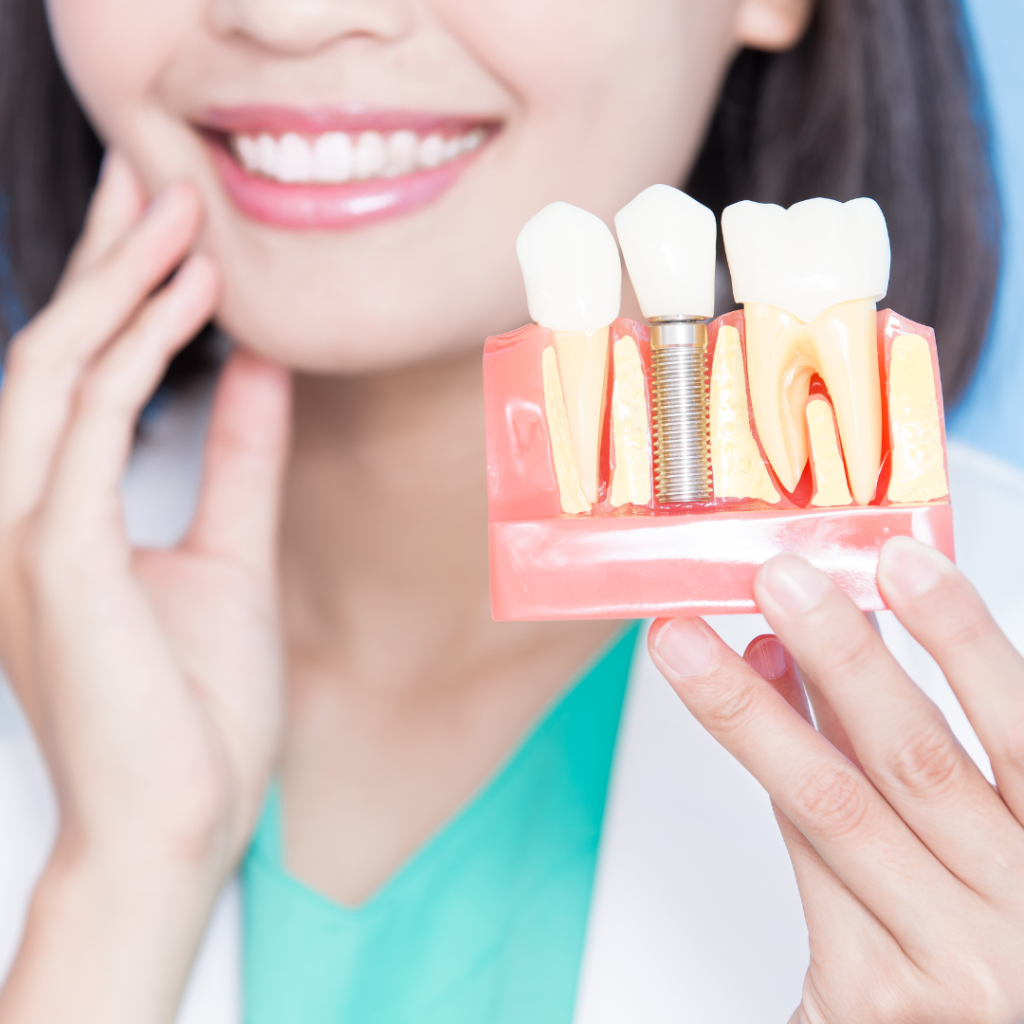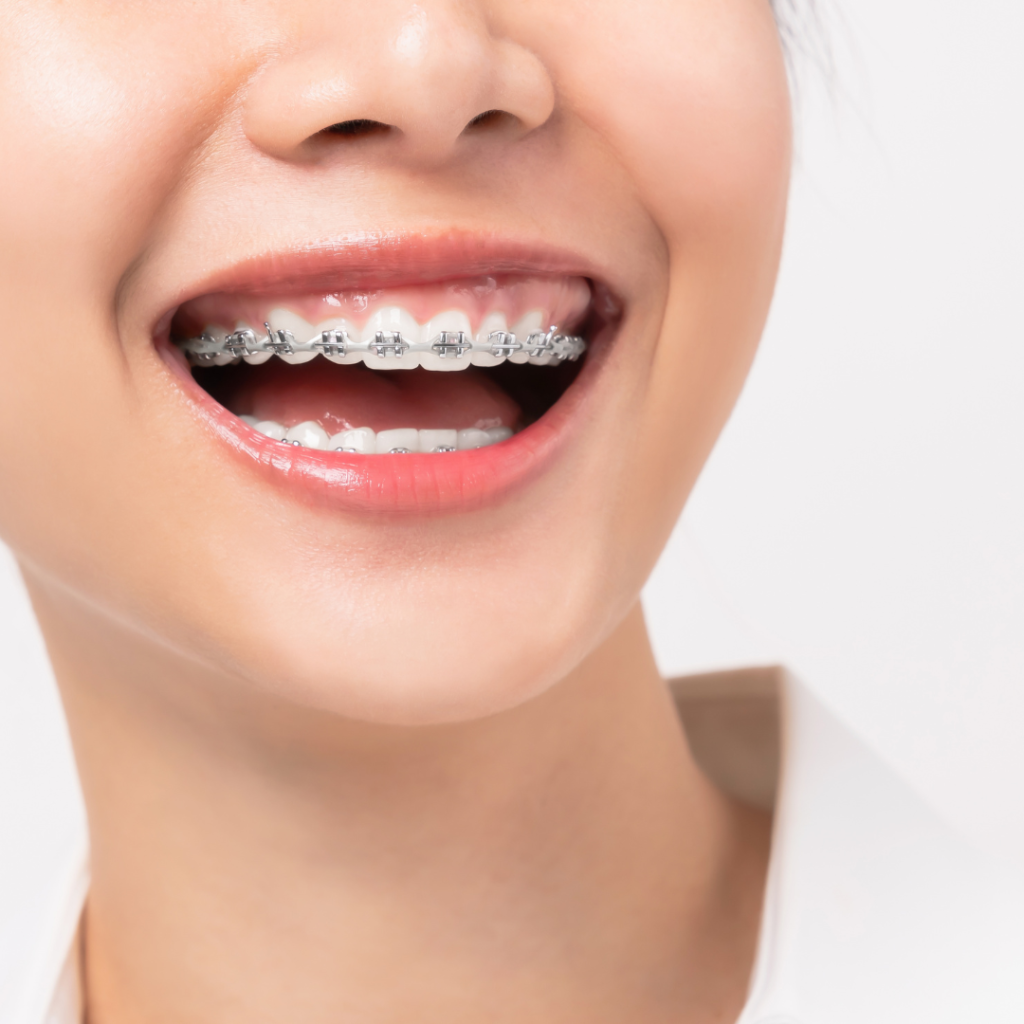Does a wisdom tooth hurt? Find out the causes and effective treatment methods at Astra Dent Warsaw
A wisdom tooth is the third molar that erupts between the ages of 17 and 35. In most cases, it does not have space for normal growth, which leads to retention (delayed eruption) or dystopia (incorrect position). As a result, local pain, swelling, inflammation of the gums, accumulation of pus, difficulty opening the mouth and swallowing occur. Without timely intervention, the risk of abscess, lymphadenitis, infection of the jaw and systemic complications increases.
Treatment at Astra Dent is based on digital diagnostics. 3D cone-beam tomography is used to assess the position of the tooth relative to the nerves and maxillary sinuses. In complex cases, piezosurgery (atraumatic bone dissection using ultrasound) is indicated, which reduces the risk of complications. In case of infectious inflammation, the oral cavity is sanitized, antibacterial therapy and antiseptics are prescribed. Surgeons with 10 years of experience adhere to international treatment standards, which guarantees effective and painless elimination of the problem.
Why choose Astra Dent Warsaw for wisdom tooth treatment?
Treatment of third molars requires precision, knowledge of anatomical risks and access to high-tech equipment. Astra Dent in Warsaw has created all the conditions for the patient to receive professional care without unnecessary procedures and trauma.
Advantages of wisdom teeth treatment at Astra Dent:
- Experienced dental surgeons. All specialists have been trained according to international standards and have experience working with unerupted, displaced and cystically altered wisdom teeth.
- Painless removal of wisdom teeth. The procedure is performed under local anesthesia or intravenous sedation. The patient does not feel any discomfort, and swelling and pain after the intervention are minimal.
- 3D tomography for accurate diagnosis. The dentistry is equipped with a cone-beam tomograph, which allows obtaining images in three projections with an accuracy of up to 0.1 mm, which reduces the risk of damage to nerves and other structures.
- Ultrasonic piezosurgery is a gentle alternative to boron. Unlike traditional drilling, the piezo device carefully separates the tooth from the bone, reducing blood loss, swelling and the risk of postoperative infection.
- Comprehensive antimicrobial support. In case of inflammation, modern antibiotics are prescribed taking into account the history and probable pathogen, as well as local antiseptics to control the bacterial load.
- Step-by-step patient information. Before, during and after the procedure, the patient receives precise recommendations: how to care for the wound, when to come for an examination, what medications to take and who to contact in case of complications.
Treatment tactics at Astra Dent are selected taking into account anatomy, age, concomitant diseases and pharmacological sensitivity. Each stage is accompanied by a clear calculation, agreed in advance. All procedures and medications are listed in the bill, with no hidden charges.
Main causes of pain
Wisdom teeth often cause discomfort even before they erupt. Most of the reasons are related to lack of space, growth disorders and the development of secondary infection:
Incorrect tooth growth (oblique, partially erupted). If the third molar erupts at an angle or only partially emerges, conditions are created for pressure on soft tissues, traumatization of the mucous membrane and the development of chronic inflammation.
- Inflammation of the gums (pericoronaritis). A hood forms over a partially erupted tooth – a section of the gums that covers the crown. Food debris and microorganisms accumulate under it, which causes inflammation. The patient complains of aching or throbbing pain, unpleasant odor, swelling, fever, difficulty swallowing.
- Caries or destruction of a wisdom tooth. Due to its remote location, the tooth is difficult to clean from plaque, which increases the risk of caries. If the infection penetrates the pulp (the inner part of the tooth), pulpitis develops – a condition that is accompanied by paroxysmal pain and requires urgent intervention.
- Pressure on neighboring teeth. If the third molar is misaligned, it presses on other teeth, causing pain, shifting of the dentition, or root destruction. Unwanted contact can cause inflammation in the area of the interdental septum and tissue loss.
- Cyst formation. A follicular cyst (a fluid-filled cavity associated with the crown of an unerupted tooth) may form in the periodontium. It gradually enlarges, compresses the bone, and causes pain and jaw deformity.
- Trigeminal neuralgia. Prolonged irritation or infection in the wisdom tooth area leads to neurogenic pain that radiates to the cheek, temple, or ear. In such cases, the pain is not always localized, often shooting or aching.
- Overloading of the masticatory apparatus. In some cases, the growth of the third molar changes the distribution of load during chewing, which causes discomfort and crunching in the temporomandibular joint.
Ignoring symptoms threatens with deterioration of the condition and complications. Abscesses, phlegmons, damage to bone tissue are not excluded. When the infection spreads beyond the jaw, systemic reactions occur that require hospitalization.
When should you urgently consult a dentist?
Not every pain in the area of the third molar requires immediate intervention, but there are symptoms that indicate the development of an acute process:
- Severe pain that does not go away. Cases when analgesics have almost no effect and the pain intensifies at night or when swallowing are especially dangerous.
- Swelling of the gums, face or jaw. This may indicate purulent inflammation or the formation of phlegmon – a widespread soft tissue infection that requires immediate sanitation.
- High temperature. An increase in temperature to 37.5 ° C often accompanies the generalization of the process, when local inflammation passes into the systemic phase – especially with an abscess and septic complications.
- Increased pain when touching the second molar. The symptom indicates pressure or contact between the teeth, which threatens resorption (destruction) of the root, the formation of an interdental cavity.
- Difficulty opening the mouth. If it is difficult to talk or chew, deep inflammation of the masticatory muscles or joint is likely.
- Sensation of numbness of the chin or lips. The symptom signals compression of the inferior alveolar nerve – a serious complication of a deep wisdom tooth.
At the first signs of inflammation, do not try to cope with the problem yourself. Consult a doctor who will conduct a diagnosis and determine whether it is possible to save the tooth (for example, with local pericoronitis), or whether removal is indicated due to the risk of relapse and complications. The decision is made based on the clinical picture, 3D scan and the condition of the surrounding tissues.
How do we treat wisdom teeth at Astra Dent Warsaw?
The approach to the treatment of third molars is always individual. Treatment at Astra Dent begins with a diagnosis of the tooth position, assessment of the condition of the gums and adjacent structures. In the case of correct positioning and no complications, therapy is aimed at eliminating the infection and stabilizing the tissue condition:
- Ultrasonic tartar removal. It is performed using a scaler with a frequency of 28-36 kHz. High-frequency vibrations destroy hard mineralized deposits on the enamel surface and in the subgingival area. The nozzle works with water cooling, which reduces tissue heating and increases the comfort of the procedure. Ultrasound partially disinfects the surface, reducing the bacterial load.
- Deep cleaning of gingival pockets. Indicated for inflammation around a partially erupted tooth. Performed with manual curettes or the Vector device with a hydroxylapatite microsuspension. The cleaning depth is up to 4-6 mm. The doctor completely removes biofilms containing pathogenic bacteria (Prevotella, Fusobacterium, Porphyromonas).
- Antiseptic applications and rinses. Prescribed in the presence of a hood, gingivitis or after surgical sanitation. Solutions of chlorhexidine 0.12-0.2%, hexetidine, hydrogen peroxide or silver citrate are used. Applications are made on sterile wipes or in gel applicators (for example, Metrogil Denta). Rinsing is recommended 2-3 times a day for 5-7 days.
- Laser treatment to reduce inflammation. A diode laser with a wavelength of 810-980 nm is used in low-power mode. Light radiation penetrates soft tissues to a depth of 5 mm, reducing swelling and inflammation. The procedure lasts 35 minutes and is painless.
In any case, the decision on treatment or removal is made after 3D tomography and clinical risk assessment.
If the tooth can be saved
Saving the wisdom tooth is possible only in the absence of root destruction, stable periodontium and sufficient space for its functioning:
- Treatment of caries or pulpitis. It is carried out under isolation with rubber dam (latex lining to protect against saliva). The canals are treated by machine endodontics using nickel-titanium instruments with depth control. Sodium hypochlorite 2.5-5% and chlorhexidine are used for disinfection. After filling the canals, photopolymer composites are used with polymerization under an LED lamp. In difficult cases, X-ray control is performed with the introduction of gutta-percha pins.
- Cleaning and antiseptic treatment of the gums. Indicated for inflammation in the hood area or swelling of the gums around the tooth. First, mechanical cleaning is performed with curettes or an ultrasonic scaler in a delicate mode. Then gels or applications with antiseptics are applied – metronidazole, triclosan, chlorhexidine. In some cases, local antibiotics in the form of a gel are used (for example, Ligosan or Elyzol).
- Antibacterial therapy for inflammation. It is prescribed in cases of pericoronaritis, purulent process or at risk of systemic complications. Broad-spectrum antibiotics are used: amoxicillin with clavulanic acid (875/125 mg 2 r/d), metronidazole (combination with penicillins) or clindamycin for allergy to β-lactams. The course of therapy is 5-7 days under symptom control. At the same time, probiotics are prescribed to prevent dysbiosis.
The procedures are performed under local anesthesia with mandatory monitoring of the condition of the gums and adjacent structures. Even after successful treatment, the preserved wisdom tooth requires periodic examination and X-ray control to exclude re-inflammation or displacement.
If the tooth needs to be removed
In the presence of retention, malposition, chronic pericoronaritis or destruction of the coronal part, preservation of the wisdom tooth is impractical. Surgical removal is performed taking into account the location of the roots, jaw anatomy, and proximity to the inferior alveolar nerve:
- Removal of a problematic wisdom tooth. The operation begins with a 3D tomogram review, which allows you to assess the shape and direction of root growth, the risks of nerve or maxillary sinus damage. In case of a difficult location, the tooth is divided into fragments using a micromotor or piezosurgical scalpel. In case of a deep location, the muco-periosteal flap is separated and access to the bone is created. After tooth extraction, the socket is washed with antiseptics (chlorhexidine, betadine), and if necessary, suture material is applied (atraumatic Vicryl or PGA 5/0 sutures are used).
- Modern methods of painless removal. Analgesia is provided with articaine anesthetics with adrenaline (Ultracain DS, Ubistesin Forte) for deep conduction or infiltration anesthesia. In case of increased anxiety, intravenous sedation is used under the control of an anesthesiologist. The method allows you to perform the intervention in half-sleep without stress and pain.
- Recovery after surgery and recommendations. Immediately after the intervention, a sterile bandage is applied, cold is prescribed for 20 minutes with breaks. It is recommended to avoid hot food, intensive rinsing and physical exertion for 2-3 days. Painkillers (ibuprofen, nimesulide), antiseptic solutions (chlorhexidine 0.12%, sage or chamomile infusion) and, if indicated, a short course of antibiotics are prescribed.
Timely removal allows you to avoid complications from neighboring teeth, the maxillary nerve and the periodontium. This prevents the development of chronic pain, bone loss and complex orthodontic or surgical treatment in the future.
How to make an appointment at Astra Dent Warsaw?
At the first symptoms of discomfort in the area of wisdom teeth, you should not delay with diagnostics. At Astra Dent in Warsaw, you will be accepted by qualified dental surgeons who specialize in complex cases of eruption and removal of wisdom teeth.
You can make an appointment in several ways:
- phone: +48 533 599 552;
- email: info@astradent.pl;
- via the website: fill out a short form on the official page.
Dentistry is open daily: from 9:00 to 20:00 on weekdays, from 9:00 to 18:00 on weekends. The appointment is organized in such a way as to avoid queues and waiting. Just choose the time that suits you.

Last update:
28 October 2025, 09:17




















